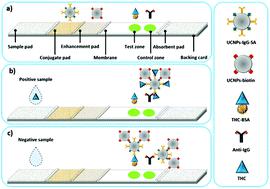Our official English website, www.x-mol.net, welcomes your
feedback! (Note: you will need to create a separate account there.)
Upconverting nanoparticle clustering based rapid quantitative detection of tetrahydrocannabinol (THC) on lateral-flow immunoassay
Analyst ( IF 3.6 ) Pub Date : 2020-10-21 , DOI: 10.1039/d0an01850c Rohit Chand 1, 2, 3, 4 , Neha Mittal 1, 2, 3, 4 , Seshasai Srinivasan 1, 2, 3, 4 , Amin Reza Rajabzadeh 1, 2, 3, 4
Analyst ( IF 3.6 ) Pub Date : 2020-10-21 , DOI: 10.1039/d0an01850c Rohit Chand 1, 2, 3, 4 , Neha Mittal 1, 2, 3, 4 , Seshasai Srinivasan 1, 2, 3, 4 , Amin Reza Rajabzadeh 1, 2, 3, 4
Affiliation

|
Cannabis, also known as marijuana, is the most abused psychoactive drug worldwide. Several countries are legalizing the medicinal and recreational use of cannabis. At the same time, stricter laws are being drafted for driving or working under the influence of the drug. Therefore, there is a significant need for rapid point-of-care testing of cannabis in biological fluids. Tetrahydrocannabinol (THC) is the parent psychoactive molecule present in cannabis and is used as a biomarker for cannabis detection. In this work, we developed an upconverting nanoparticle (UCNP) based lateral-flow immunoassay (LFIA) for the point-of-care quantitative detection of THC in oral fluids of drug-impaired personnel. UCNPs convert near-infrared excitation into visible emissions and have superior properties over other fluorescent nanoparticles. We employed a novel signal amplification technique for enhancing the sensitivity of LFIA. Contrary to standard LFIA biosensors, we integrated an additional enhancement pad (EP) between the conjugate pad (CP) and nitrocellulose membrane. UCNPs dually conjugated with THC specific immunoglobulin G and streptavidin (UCNP–IgG–SA) and UCNPs conjugated with biotin (UCNP–biotin) were dried in CP and EP, respectively. UCNP–IgG–SA, upon interacting with THC, flow through the EP and bind with UCNP–biotin, consequently forming bright UCNP clusters on the test and control zones. The test signals were captured after an assay time of 20 minutes. An experimental detection limit of 2 ng mL−1 for THC with a linear detection range of 2–15 ng mL−1 was achieved. The developed LFIA has the potential to be used as a point-of-care detection device for the quantitative detection of THC.
中文翻译:

基于上转换纳米粒子簇的四氢大麻酚(THC)快速定量检测
大麻,也被称为大麻,是全世界滥用最严重的精神药物。有几个国家正在使大麻的药用和娱乐使用合法化。同时,正在起草更严格的法律,以在毒品的影响下驾驶或工作。因此,迫切需要对生物液体中的大麻进行快速即时检测。四氢大麻酚(THC)是大麻中存在的母体精神活性分子,并用作大麻检测的生物标记。在这项工作中,我们开发了一种基于上转换纳米粒子(UCNP)的侧流免疫测定(LFIA),用于在现场对毒品残障人员的口服液中的四氢大麻酚进行定量检测。UCNP将近红外激发转换为可见光发射,并具有优于其他荧光纳米粒子的特性。我们采用了一种新颖的信号放大技术来增强LFIA的灵敏度。与标准LFIA生物传感器相反,我们在共轭垫(CP)和硝酸纤维素膜之间集成了一个附加的增强垫(EP)。将分别与THC特异性免疫球蛋白G和抗生蛋白链菌素(UCNP–IgG–SA)双重偶联的UCNP和与生物素(UCNP–生物素)偶联的UCNP分别在CP和EP中干燥。UCNP–IgG–SA与THC相互作用后,流经EP并与UCNP–生物素结合,因此在测试区和对照区形成了明亮的UCNP簇。在20分钟的分析时间后捕获测试信号。实验检测限为2 ng mL 我们在共轭垫(CP)和硝酸纤维素膜之间集成了一个附加的增强垫(EP)。将分别与THC特异性免疫球蛋白G和抗生蛋白链菌素(UCNP–IgG–SA)双重偶联的UCNP和与生物素(UCNP–生物素)偶联的UCNP分别在CP和EP中干燥。UCNP–IgG–SA与THC相互作用后,流经EP并与UCNP–生物素结合,因此在测试区和对照区形成了明亮的UCNP簇。在20分钟的分析时间后捕获测试信号。实验检测限为2 ng mL 我们在共轭垫(CP)和硝酸纤维素膜之间集成了一个附加的增强垫(EP)。将分别与THC特异性免疫球蛋白G和抗生蛋白链菌素(UCNP–IgG–SA)双重偶联的UCNP和与生物素(UCNP–生物素)偶联的UCNP分别在CP和EP中干燥。UCNP–IgG–SA与THC相互作用后,流经EP并与UCNP–生物素结合,因此在测试区和对照区形成了明亮的UCNP簇。在20分钟的分析时间后捕获测试信号。实验检测限为2 ng mL 因此,在测试和控制区域上形成了明亮的UCNP簇。在20分钟的分析时间后捕获测试信号。实验检测限为2 ng mL 因此,在测试和控制区域上形成了明亮的UCNP簇。在20分钟的分析时间后捕获测试信号。实验检测限为2 ng mL-1用于THC与2-15纳克mL的线性检测范围-1达到了。研发的LFIA有可能用作即时检测THC的现场检测设备。
更新日期:2020-11-12
中文翻译:

基于上转换纳米粒子簇的四氢大麻酚(THC)快速定量检测
大麻,也被称为大麻,是全世界滥用最严重的精神药物。有几个国家正在使大麻的药用和娱乐使用合法化。同时,正在起草更严格的法律,以在毒品的影响下驾驶或工作。因此,迫切需要对生物液体中的大麻进行快速即时检测。四氢大麻酚(THC)是大麻中存在的母体精神活性分子,并用作大麻检测的生物标记。在这项工作中,我们开发了一种基于上转换纳米粒子(UCNP)的侧流免疫测定(LFIA),用于在现场对毒品残障人员的口服液中的四氢大麻酚进行定量检测。UCNP将近红外激发转换为可见光发射,并具有优于其他荧光纳米粒子的特性。我们采用了一种新颖的信号放大技术来增强LFIA的灵敏度。与标准LFIA生物传感器相反,我们在共轭垫(CP)和硝酸纤维素膜之间集成了一个附加的增强垫(EP)。将分别与THC特异性免疫球蛋白G和抗生蛋白链菌素(UCNP–IgG–SA)双重偶联的UCNP和与生物素(UCNP–生物素)偶联的UCNP分别在CP和EP中干燥。UCNP–IgG–SA与THC相互作用后,流经EP并与UCNP–生物素结合,因此在测试区和对照区形成了明亮的UCNP簇。在20分钟的分析时间后捕获测试信号。实验检测限为2 ng mL 我们在共轭垫(CP)和硝酸纤维素膜之间集成了一个附加的增强垫(EP)。将分别与THC特异性免疫球蛋白G和抗生蛋白链菌素(UCNP–IgG–SA)双重偶联的UCNP和与生物素(UCNP–生物素)偶联的UCNP分别在CP和EP中干燥。UCNP–IgG–SA与THC相互作用后,流经EP并与UCNP–生物素结合,因此在测试区和对照区形成了明亮的UCNP簇。在20分钟的分析时间后捕获测试信号。实验检测限为2 ng mL 我们在共轭垫(CP)和硝酸纤维素膜之间集成了一个附加的增强垫(EP)。将分别与THC特异性免疫球蛋白G和抗生蛋白链菌素(UCNP–IgG–SA)双重偶联的UCNP和与生物素(UCNP–生物素)偶联的UCNP分别在CP和EP中干燥。UCNP–IgG–SA与THC相互作用后,流经EP并与UCNP–生物素结合,因此在测试区和对照区形成了明亮的UCNP簇。在20分钟的分析时间后捕获测试信号。实验检测限为2 ng mL 因此,在测试和控制区域上形成了明亮的UCNP簇。在20分钟的分析时间后捕获测试信号。实验检测限为2 ng mL 因此,在测试和控制区域上形成了明亮的UCNP簇。在20分钟的分析时间后捕获测试信号。实验检测限为2 ng mL-1用于THC与2-15纳克mL的线性检测范围-1达到了。研发的LFIA有可能用作即时检测THC的现场检测设备。











































 京公网安备 11010802027423号
京公网安备 11010802027423号